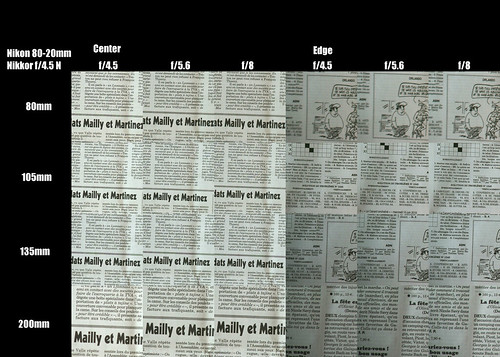In keeping with my now standard way of looking at resolution and contrast in lenses, I thought I'd put an old Nikon Nikkor 80-200mm f/4.5 N Ai through it's paces and see how it did with le canard enchaine.
I picked this lens up for around 80Euro. I know. I paid way too much for it. To make matters worse, it's well used and the push-pull zoom barrel does not slide entirely smoothly. It's not bad, but it's definitely not as silky smooth as the 80-200mm f/4 Ai-S that I recently foolishly sold. Oh well, I was in a house cleaning stage and was looking to downsize my collection of lenses.
Comparison setup -

So, what do we see here? Simply, Nikon's old zoom is a very fine objective at all focal lengths and all apertures. Only at 80 mm's did the lens suffer at the extreme edges of the frame. Everything else is tack-sharp across the frame.
Looking at the other comparisons that I've performed, can you tell any difference between this lens and fixed focal-length lenses? Think about that a moment. Impressive, isn't it?
The primary thing that is given up by using this zoom is maximum aperture speed. If you want to blur the background by shooting at a wide aperture, use a fixed focal length lens. If you want sharp images from a variety of focal lengths but only want to carry one lens, it'd be hard to beat this zoom as a one package solution.
I picked this lens up for around 80Euro. I know. I paid way too much for it. To make matters worse, it's well used and the push-pull zoom barrel does not slide entirely smoothly. It's not bad, but it's definitely not as silky smooth as the 80-200mm f/4 Ai-S that I recently foolishly sold. Oh well, I was in a house cleaning stage and was looking to downsize my collection of lenses.
Comparison setup -
- Some pages out of a local newspaper taped to the bedroom wall
- Sony A6000 set to "A", 100 ISO, 2second delay
- Massive Manfrotto tripod
- Zhongyi Lens Turbo II focal reducer
- No sharpening applied to the RAW output
- 500 pixel sections were taken from the various images and organized below

So, what do we see here? Simply, Nikon's old zoom is a very fine objective at all focal lengths and all apertures. Only at 80 mm's did the lens suffer at the extreme edges of the frame. Everything else is tack-sharp across the frame.
Looking at the other comparisons that I've performed, can you tell any difference between this lens and fixed focal-length lenses? Think about that a moment. Impressive, isn't it?
The primary thing that is given up by using this zoom is maximum aperture speed. If you want to blur the background by shooting at a wide aperture, use a fixed focal length lens. If you want sharp images from a variety of focal lengths but only want to carry one lens, it'd be hard to beat this zoom as a one package solution.
No comments:
Post a Comment